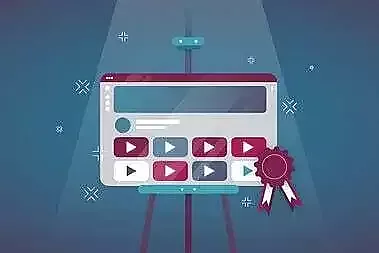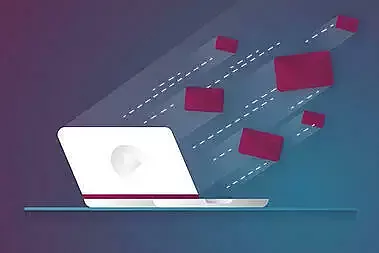From initial interest to enthusiastic customer: The Sales Funnel describes every phase of your sales process. Here you will learn how to optimize your funnel with the use of videos in order to win and retain customers.
The heart of every professional online marketing strategy: The Sales Funnel. It describes the pattern of a prospective customer from initial interest through the final sale – the classic purchase process, which each human runs through.
The funnel shape is created by this exact stream: while at the entrance of the funnel, we are talking about a comparatively large number of users, along the way to conversion, many jump off – in online markets, only about 2% of the initial visitors convert.
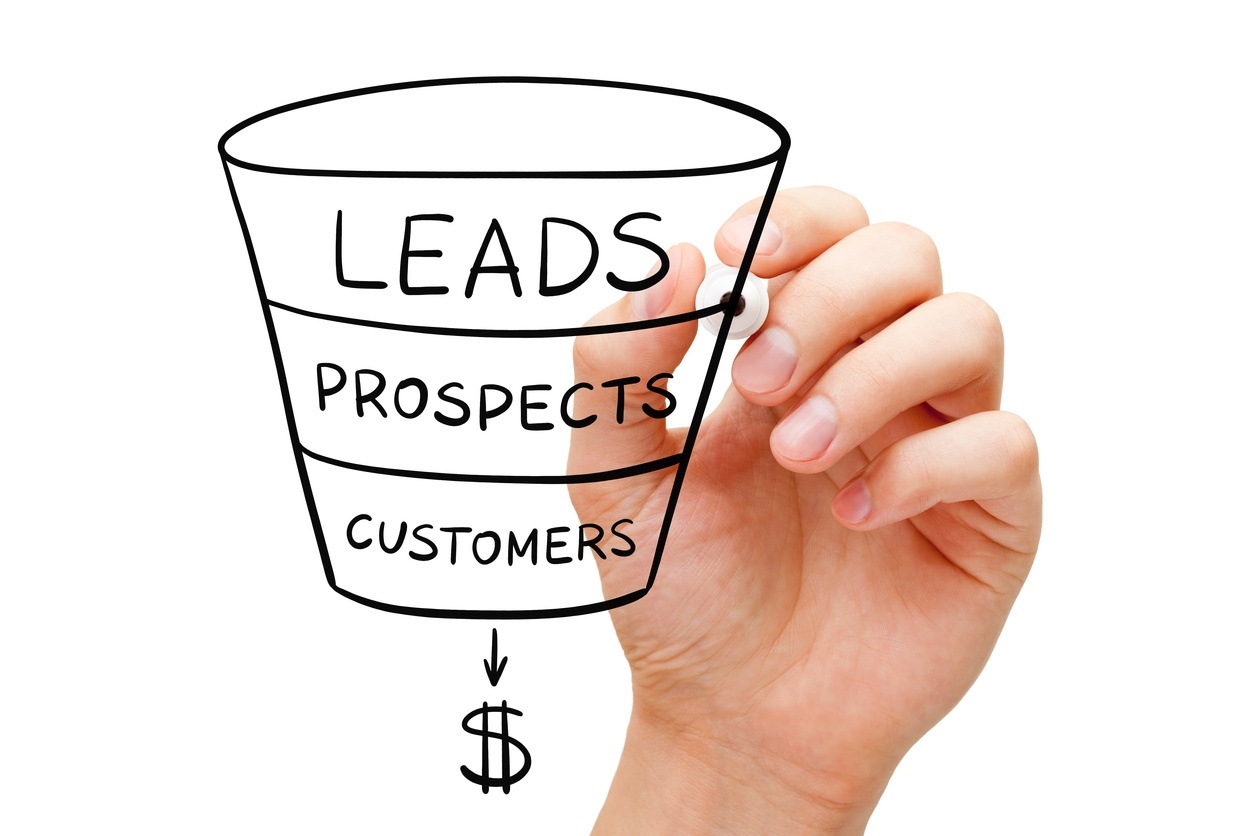
The funnel-shaped "sales funnel" is the heart of every online marketing strategy.
And so, only 22% of companies are satisfied with their conversion rates. The art lies in finding out why users don’t convert and how this can be counteracted. Reasons include lengthy loading times or incorrect forwarding.
As an online merchant, you want to patch up these "leaks" and make the process as efficient as possible: You bring users to your website through search engine advertising, good content, and advertising, and use conversion rate optimization to keep them there, convince them of your offer, and finally turn as many customers as possible into returning customers.
Promising success in each of these phases: the use of videos.
Creative, professional videos help you immensely with topics such as SEO and conversion rate optimization.
But first, we want to get a better overview of the Sales Funnel and its individual stages.
An overview: From interested party to brand ambassador.
Let's take a closer look at the funnel. In marketing jargon, we speak of three areas: Top, Middle, and Bottom of the Funnel – in short TOFU, MOFU, and BOFU.
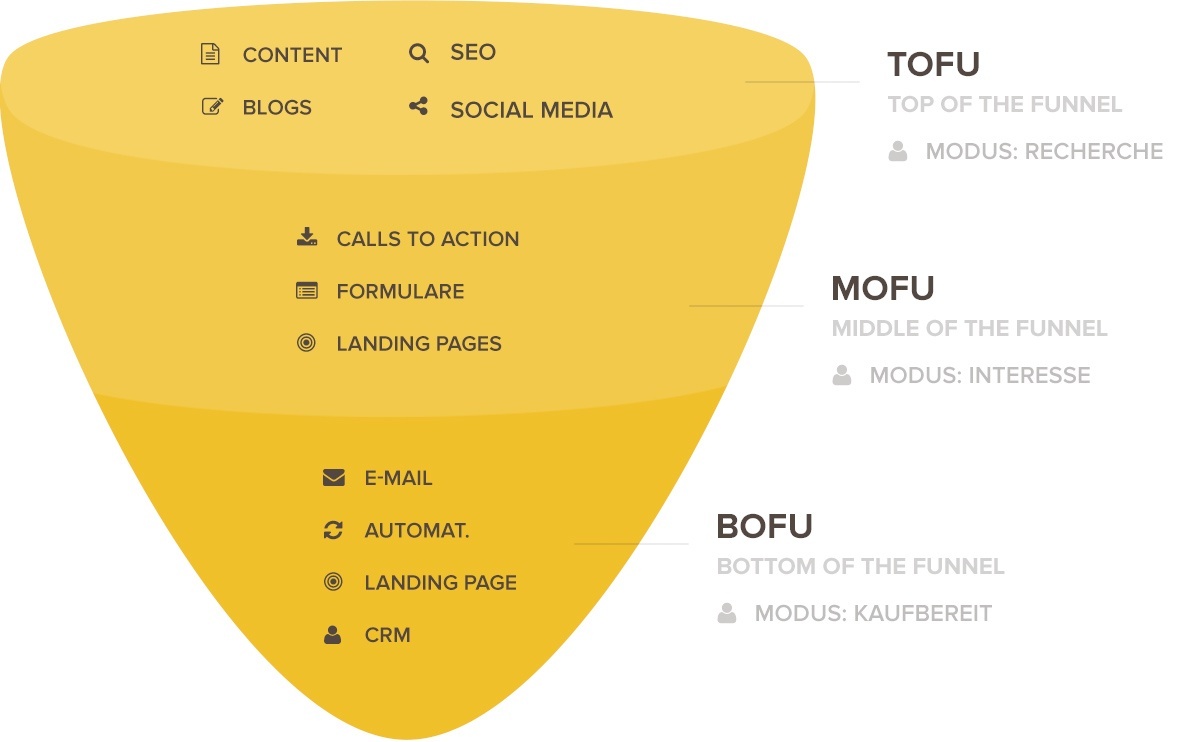
What does the Sales Funnel look like? Chimpify clearly presents the individual phases.
In the TOFU, we reach people who are only looking for information – no sales messages are appropriate here yet.
If users are looking for concrete solutions to their problems, they are in MOFU. Here, different providers and their respective content are compared with each other. If the user develops enough trust, he leaves his contact data in this step and becomes a "lead.”
In the BOFU, our lead has collected all the necessary information and is able to make an informed purchase decision. Ideally, he is so satisfied with the product and customer service that he will return at a later date and even share his positive experience with others.
This explainer videoof Rabbit Mobile shows the importance of digitalisation. (Video produced by Mynd).
Tip:
Along your sales funnel, you accompany your potential customers with the appropriate free and chargeable offers and help them to solve their problems.
One possible way to accompany your customers is to use video. In the next step, we will explain why this is particularly worthwhile.
Why is the use of video worthwhile?
Initially, many companies are skeptical about investing in a professionally-created video. However, 83% of companies report a good return on investment.
Simple and easy to understand: Walmart uses explainer videos to illustrate its shopping diversity.
In addition, 57% of users report gaining more confidence in a company through use of videos and are more likely to click "buy”. Customers love easily-consumable information, and thus, videos help you increase your online conversion rate and sell more of your product.
Search engines also love the use of video. Videos and animations mean that users spend up to 88% more time on your site, and a page with embedded video is 53 times more likely to rank first in Google search results.
Modern communication: Novum also relies on videos (video produced by Mynd).
The optimal duration of your video depends on the exact location in your sales funnel. At the beginning, when a prospective customer is only looking for information, about 1 minute of video serves its purpose.
In the later course of your sales process, on the other hand, you should go into more depth. For example, Wistia presents its company and product in just under 3 minutes, while the well-known Dollar Shave Club video runs about 1.5 minutes long.
In 1.5 minutes, entertaining explained: The successful marketing video of Dollar Shave Club.
Alles klar, Videos eignen sich also aus Unternehmens-, Kunden- und Marketingsicht, um alle Beteiligten zufriedenzustellen. Wie sieht dies jedoch genau für die einzelnen Phasen des Sales Funnels aus?
So from a corporate, customer, and marketing perspective, videos are great for satisfying everyone. But what exactly does this look like for each phase of the sales funnel?
Step 1: Attract attention.
The journey naturally begins with traffic, and "content is king" is still the motto: 65% of B2B marketers report a more successful content marketing strategy than in the previous year. However, this content must also reach the right people.
Now you might ask yourself: Who exactly are my "right people"?
Until this question is clarified clearly, it makes little sense strategically to simply create content on a whim and hope that it reaches the right people.
First of all, you should have a clear idea of your “buyer persona”, a fictional person representing your typical customer, with a problem or wish that your company can solve.
Now it's time to attract this person. You will achieve this with high-quality content that adds value and is available free of charge on a platform or your blog.

At the very beginning: prospective customers research information about their problem by means of search engines.
The next step is marketing. Start by optimizing your content for the search engine. In general, it can take several months to achieve measurable success through SEO, but it is worthwhile to optimize well at the beginning so that you "automatically" rank well in the future.
Then you can advertise your content via social media platforms such as your company's Facebook page, in groups, or on your private profile. Here, it is worthwhile to tailor your content specifically to the respective platform in order to get the most out of it and to place successful ad campaigns. Here's how to optimize video content for ideal performance on Facebook and YouTube.
And that's why videos are also great here: they are often shared through entertainment and the appeal of emotions, and in the best case, even spread virally, like this commercial from Volvo.
By telling a moving story, Volvo celebrates a safe world without traffic accidents
What to do if it doesn't really work out?
You put all this into practice, but you still have problems getting interested parties on your side and generating potential leads?
In this case, animated explainer videos are the perfect way to attract the attention of your audience. Carry out targeted keyword research to find out which questions and problems are current in your industry.
So you can choose a topic for your video that answers the questions of your potential leads. If your video does this satisfactorily, your visitors are more likely to continue reading, consume more of your content, and – ideally – convert.
A concrete problem explained and solved in an entertaining way: T.CON uses an animated explainer video (produced by Mynd).
Tip:
The first step is to define your buyer persona, identify your specific problem, and solve it with free content that adds value.
Step 2: Retain users.
So your content is read and shared. Now what? In the next step, this should lead to downloads, subscriptions, or sales.
At this point, you should build trust with your customer and convey the feeling that your product is desirable. You can use an exclusive offer for your social media followers, testimonials, or satisfaction guarantees.
For the conversion step itself, use Calls-To-Action (CTAs): concrete requests for action, such as "Click here to receive a free initial consultation.” These are usually located in banners that lead to a corresponding landing page that focuses solely on the execution of this CTA.
What are the benefits to your visitor of filling out your contact form or leaving their information behind? In return for his data, offer him another added value, a so-called “goodie.”
And here, too, the use of video is worthwhile: For example, a product video on a landing page can increase conversion by 80%.
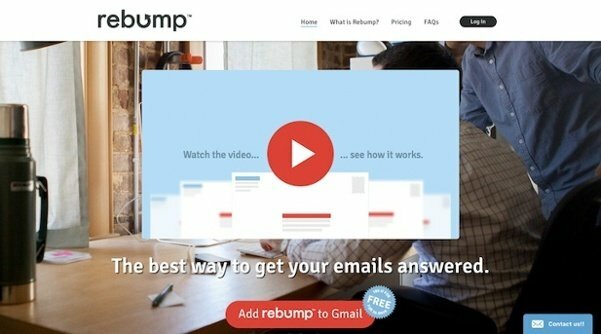
Rebump presents its email automation software in an informative way by means of a video on its landing page.
Problems with funnel level 2?
If many leads "get out" of your funnel at this point, concentrate on presenting your offer in an even easier to understand and accessible way, such as with a demo video or a free trial period. Communicate unmistakably that your product solves the problem simply, effectively, and successfully.
Tip:
Use personalization, targeted call-to-actions, and conversion-optimized landing pages to turn your visitor into a lead.
Step 3: Motivate users to buy.
Your visitor has now become a lead, and now he should become a customer. Email marketing is one of the most effective communication channels here.
Apart from the fact that email has a ROI of $41, a video embedded in the email increases the click-through rate by an amazing 96%! The best way to do this is with automation – like an autoresponder that automatically sends an email after a set number of days.
Also, try to personalize your offer as much as possible by using available analytics and user behavior. Respond specifically to customers’ interests. The more precisely your offer is tailored to a visitor, the more likely the conversion.
Use all available data to analyze and further optimize this step of the process. Take a look, for example, at which emails achieve particularly good click-through rates. In addition, you should still rely on manual relationship building, for example through personal replies to emails and comments, or through surveys. Be interactive!
As soon as your lead has all the necessary information, however, you can draw its attention to your offer – again, with a landing page that shows the advantages of your solution.
If you find it difficult to turn your leads into customers, present additional trust factors. For example, produce videos of your customers' successes and testimonials. We trust the recommendations of others. Show a real business with real success from your product, and your leads are more likely to make a positive purchase decision.
Unterstützt die Kaufentscheidung Ihrer Leads: Ein Testimonial-Video wie dieses von Evernote.
Tip:
Use email marketing, automation, and targeted landing pages to convince your lead to buy.
Step 4: Inspire.
In the final step, you not only want to satisfy your customers, but even exceed their expectations.
A click on your "Buy" button is not the end of a successful conversion. Returning visitors and recommendations are just as important.
Here, too, the use of professionally-created videos is recommended: 75% of surveyed YouTube users shared company videos with their friends if they liked them.
And there’s room to get creative! Especially on special occasions and holidays, you can use videos to draw the attention of prospective customers to yourself and inform existing customers about further offers, and thus, ultimately increase your sales in the upcoming holiday business. How about an elegant Christmas video, for example?
So keep delivering free, value-added content and utilize personalization. For your customers, relevant news, further recommendations, and case studies are attractive here--something that gives them a good feeling about their purchase decision.
Little by little, you can then introduce your customers to possible follow-up products. It would be easy to drop your customer relationship after the sale for more focus on traffic and leads, but today's customers love personalized offers and brand integration in their everyday lives.
For qualitative feedback, use the opportunity of surveys to conduct market research in addition to analyzing your website and social media channels. In this way you can see where your sales funnel is still lacking and where there is room for improvement.
And what if things don't really work out?
If you don't succeed in keeping your customers enthusiastic, you can provide a How-To video. Most customers want quick and easy answers by searching online, and emails or phone calls are avoided if possible. A How-To video helps them deal with the topic on their own and at their own pace.
How-To videos, like this one from Photoshop teach your audience a new way to reach their goal independently.
Tip:
Exceed your customer's expectations with more content and personalized recommendations, making them brand ambassadors.
Get started right away!
Get started right away!
So to summarize again:
First, attract your potential customers with high-quality content by distributing it via blogs, social media, and search engines.
Next, convert the incoming visitors with forms, CTAs, and landing pages.
Then, use email marketing, automation, and landing pages again to get this lead to buy.
The fourth and final step is to engage your customers with more valuable content, use personalization and surveys, and turn them into brand ambassadors who attract more prospects. And then, the whole process starts over again.
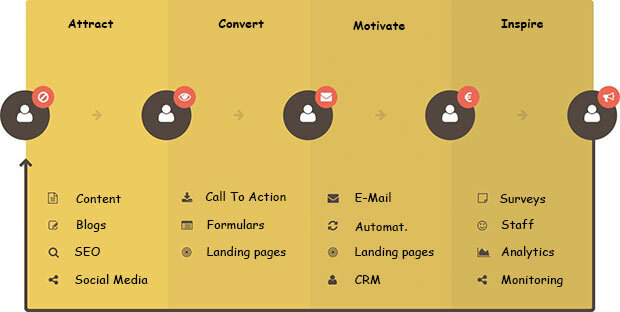
Chimpify sums it up: The path from prospect to returning customer.
We've also explained why you should use videos at every step and how this can help you progress through the sales funnel.
Whether and what type of moving image you choose depends primarily on your target audience.
But there is one thing on which you should never compromise: The quality.
Entertaining cat videos can sometimes go viral when pixelated, but you should not make any compromises for your company. According to the Wall Street Journal, 9 out of 10 viral YouTube videos were produced professionally in 2012.
We will gladly advise you on possible formats for a successful video, free of charge, and without obligation. And now: Good luck in optimizing your sales funnel!



